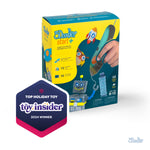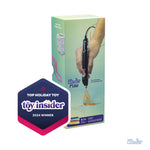Frozen Bubble Bubble Wands
Students will work in pairs to create 2 different bubble wands. The wands should have 2 different shapes. They will compare their bubbles’ footprints (diameters) to see the difference. They will hypothesize the outcome of their bubbles and measure the diameters. They will make observations regarding the general shape of their frozen bubbles.

KnowledgeStudents haveHad explicit instruction in the Scientific Method regarding making hypotheses and collecting data (making observations)
A working knowledge of using a ruler to measure the diameter of a circle
A working knowledge of 3Doodler Create pens
Had explicit instruction in the Scientific Method regarding making hypotheses and collecting data (making observations)
A working knowledge of using a ruler to measure the diameter of a circle
A working knowledge of 3Doodler Create pens
ObjectivesStudents willWork together in pairs to design/build bubble wands
Make hypotheses regarding the shapes of bubbles based on designed wands
Make observations (qualitative as well as quantitative)
Take measurements using the appropriate tools
Design a method to measure the diameter of a bubble
Work together in pairs to design/build bubble wands
Make hypotheses regarding the shapes of bubbles based on designed wands
Make observations (qualitative as well as quantitative)
Take measurements using the appropriate tools
Design a method to measure the diameter of a bubble
MaterialsStudents will needAccess to iPads w/ 3Doodler App (optional for stencils)
Ruler/Calipers
Long sheets of paper
Small fan for making bubbles
Bubble Solution (colored with a drop of food coloring - 3 different colors suggested)
Small bubble wands for student experimentation
Stopwatch to measure longest lasting bubble
Knit gloves for catching bubbles
Worksheets Bubble Wand Challenge
Spreadsheet for data collection (w/ class data summary & formulae)
Access to iPads w/ 3Doodler App (optional for stencils)
Ruler/Calipers
Long sheets of paper
Small fan for making bubbles
Bubble Solution (colored with a drop of food coloring - 3 different colors suggested)
Small bubble wands for student experimentation
Stopwatch to measure longest lasting bubble
Knit gloves for catching bubbles
Worksheets Bubble Wand Challenge
Spreadsheet for data collection (w/ class data summary & formulae)
Lesson PlanInstructions
Step 1Review with students diameter and other vocabulary related to spheres and circles learned previously.
Step 2Have students practice using 3Doodler Create+ pens: What is filament? What does it mean to extrude filament? What do the buttons do? How do you connect 2 pieces of extruded plastic? Students who have never used a 3Doodler before may want to practice extruding filament.
Pay particular attention to safety precautions while using 3Doodler Create+ pens, especially how to avoid burning yourself. Make sure students do not have pens plugged in across working/walking surfaces. Reinforce that pens should be turned off and unplugged when not in use to avoid potential burns. Keep pens from melting/burning countertops, etc. but setting them down appropriately. NEVER doodle on any surface other than the 3Doodler Doodle Pad.
Step 3Pair students together. Let them know they will be designing bubble wands in 2 different shapes. Allow students to make bubbles with the provided bubble wands. Encourage them to pay attention to the design of the wands and what purpose the design may serve. Make sure they use the colored bubble solution and allow the bubbles to land on the long sheets of paper.
Have students record their observations on the worksheet. They must make at least 1 qualitative observation and 1 quantitative observation about the bubbles they blow in this exploration activity.

![]()
![]() Step 4
Step 4Have students answer the questions leading up to designing their wands. Encourage them to discuss their ideas with each other. They can then design a quick survey using Google Forms to share with their classmates asking for ideas for their bubble wands. Show students how to view the compiled responses in a Google Sheet once everyone has taken the survey.
Step 5Students will use their answers on their worksheets and the results of their surveys to sketch and create their bubble wands using the 3Doodler Create+ pens.
Step 6Once wands have been created, students should once again make bubbles with the colored bubble solution (different colored solutions for each shape would be ideal). Students should collect the appropriate data for their worksheets (qualitative and quantitative).
Step 7Now that wands are created, allow students to freeze bubbles for measurement. (See dry ice frozen bubbles article in Resources section.) If temperatures are appropriate, allow students to dress warmly and take their experiments outside. Carefully help students measure frozen bubbles.
Note: Freezing bubbles either with dry ice or outside is a precise process. Certain bubble solutions contain too much glycerin to freeze easily and students are often not patient enough to wait for this to happen. Handling frozen bubbles is also quite tricky. The method of measuring bubbles based on the colored ring they leave on the rolled out paper makes a great, simplified alternative.
Step 8Once all data has been collected, allow student pairs to record their findings in the class spreadsheet. Have students answer questions reflecting on their experiments/experiences.
Step 9Discuss the results of the experiments. Display/discuss the class spreadsheet findings. Compare the class process to how scientists in different locations can work together and share data. Depending upon the skill level of the class, the teacher can demonstrate programming cells to use the observed measurements to calculate other dimensions of spheres.
Review with students diameter and other vocabulary related to spheres and circles learned previously.
Have students practice using 3Doodler Create+ pens: What is filament? What does it mean to extrude filament? What do the buttons do? How do you connect 2 pieces of extruded plastic? Students who have never used a 3Doodler before may want to practice extruding filament.
Pay particular attention to safety precautions while using 3Doodler Create+ pens, especially how to avoid burning yourself. Make sure students do not have pens plugged in across working/walking surfaces. Reinforce that pens should be turned off and unplugged when not in use to avoid potential burns. Keep pens from melting/burning countertops, etc. but setting them down appropriately. NEVER doodle on any surface other than the 3Doodler Doodle Pad.
Pair students together. Let them know they will be designing bubble wands in 2 different shapes. Allow students to make bubbles with the provided bubble wands. Encourage them to pay attention to the design of the wands and what purpose the design may serve. Make sure they use the colored bubble solution and allow the bubbles to land on the long sheets of paper.
Have students record their observations on the worksheet. They must make at least 1 qualitative observation and 1 quantitative observation about the bubbles they blow in this exploration activity.

Have students answer the questions leading up to designing their wands. Encourage them to discuss their ideas with each other. They can then design a quick survey using Google Forms to share with their classmates asking for ideas for their bubble wands. Show students how to view the compiled responses in a Google Sheet once everyone has taken the survey.
Students will use their answers on their worksheets and the results of their surveys to sketch and create their bubble wands using the 3Doodler Create+ pens.
Once wands have been created, students should once again make bubbles with the colored bubble solution (different colored solutions for each shape would be ideal). Students should collect the appropriate data for their worksheets (qualitative and quantitative).
Now that wands are created, allow students to freeze bubbles for measurement. (See dry ice frozen bubbles article in Resources section.) If temperatures are appropriate, allow students to dress warmly and take their experiments outside. Carefully help students measure frozen bubbles.
Note: Freezing bubbles either with dry ice or outside is a precise process. Certain bubble solutions contain too much glycerin to freeze easily and students are often not patient enough to wait for this to happen. Handling frozen bubbles is also quite tricky. The method of measuring bubbles based on the colored ring they leave on the rolled out paper makes a great, simplified alternative.
Once all data has been collected, allow student pairs to record their findings in the class spreadsheet. Have students answer questions reflecting on their experiments/experiences.
Discuss the results of the experiments. Display/discuss the class spreadsheet findings. Compare the class process to how scientists in different locations can work together and share data. Depending upon the skill level of the class, the teacher can demonstrate programming cells to use the observed measurements to calculate other dimensions of spheres.
Wrap Up
Assessment
Possible Extensions
Vocabulary
DIAMETER - a straight line passing from side to side through the center of a body or figure, especially a circle or sphere.
Extrude - The act of plastic being melted and then ejected from the 3Doodler as a steady stream, similar to a thread until stopped.
FILAMENT - 3D printing filament is the thermoplastic feedstock for fused deposition modeling 3D printers.
hypothesis - a supposition or proposed explanation made on the basis of limited evidence as a starting point for further investigation.
QUALITATIVE OBSERVATION - data collected during an experiment by using your 5 senses
QUANTITATIVE OBSERVATION - data collected during an experiment, recorded as measurements
Educational Standards
Collect data using computational tools and transform the data to make it more useful and reliable.
Students will record the diameters of their bubbles in a spreadsheet for further calculations, changing diameter measurements into a variety of metrics for spheres.
Collaborate with many contributors through strategies such as crowdsourcing or surveys when creating a computational artifact.
Students will create one final chart/spreadsheet that incorporates the data collected from all the student pairs in the room, using Google Sheets.
Define the criteria and constraints of a design problem with sufficient precision to ensure a successful solution, taking into account relevant scientific principles and potential impacts on people and the natural environment that may limit possible solutions.
Students will design and construct bubble wands to collect data.
Analyze data from tests to determine similarities and differences among several design solutions to identify the best characteristics of each that can be combined into a new solution to better meet the criteria for success.
Students will examine the whole class data set to determine if there is a relationship between the shape of the bubble wands and the diameter of the bubbles.
Students choose the appropriate platforms and tools for meeting the desired objectives of their creation or communication.
Students will choose the platform best suited to sharing their data.
Students use collaborative technologies to work with others, including peers, experts or community members, to examine issues and problems from multiple viewpoints.
Students will share their data with other teams to evaluate/reinforce their own findings.
Students contribute constructively to project teams, assuming various roles and responsibilities to work effectively toward a common goal.
Students will work together to answer questions and build the bubble wands.
Prepare for and participate effectively in a range of conversations and collaborations with diverse partners, building on others' ideas and expressing their own clearly and persuasively.
Students will be working in partners to design bubble wands with 2 different shapes.
Present information, findings, and supporting evidence such that listeners can follow the line of reasoning and the organization, development, and style are appropriate to task, purpose, and audience.
Students will be evaluating and conferencing with other student teams regarding their bubble wand designs.





